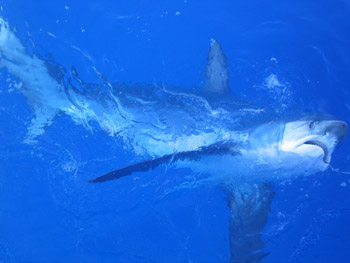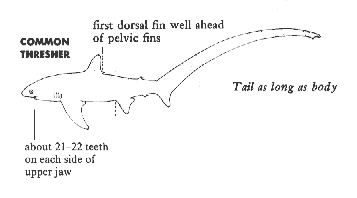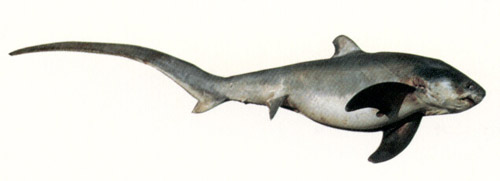Common Thresher Shark

Common Name: Common Thresher Shark
Scientific Name: Alopias vulpinus
Description
The body of the common thresher shark is moderately elongate. The snout is rather short, and the mouth crescent shaped. The first dorsal fin is large, and located midway between the pectoral and ventral fins. The second dorsal and anal fins are very small. The tail is distinctive since it is very long, almost as long as the rest of the body. The coloration may vary from brownish gray, bluish or blackish above to silvery, bluish or golden below. The dorsal, pectoral and ventral fins are blackish and sometimes the pectoral and ventral fins have a white dot in the lip. The bigeye thresher also occurs off the California coast. It can be distinguished by its large eye; however, if you can count the teeth in the upper jaw, the common thresher has 21 - 22 on each side while the bigeye thresher has 10 - 11 on each side.

Range
The common thresher shark occurs worldwide in warmer seas. In the eastern North Pacific, it is found from central Baja California, to the Strait of Juan de Fuca, British Columbia. The common thresher is an inhabitant of the upper layers of deep offshore waters and is most abundant in areas of steep bottom contour along the edges of the continental shelf. During the spring and summer months smaller threshers may occur near shore where they are often seen leaping completely out of the water.
Natural History
The food habits of the thresher are not well known, but on the California coast they feed mostly upon small fish such as sardines, anchovies, mackerel, and squid. They are said to use their long tail as a flail to frighten or stun their prey. The common thresher shark bears live young and appears to become sexually mature in 6 or 7 years. Four pups are produced annually. A 18 foot female contained four young that weighed 13.5 pounds each and were 4 to 4.5 feet long.
 Fishing Information
Fishing Information
Most thresher sharks caught off California have been taken on live sardines, anchovies, or mackerel. Best localities have been the San Francisco Bay area, the inshore coastal water between Point Conception and Port Hueneme, and Santa Monica Bay, especially around Malibu and Paradise Cove. They are most abundant during the summer months. Considered a fine game species on light or medium tackle, they often put on an aerial demonstration. At other times the battle is entirely beneath the surface and consists of brute strength and shift-towing tactics. An angler would do well to bait a live mackerel on a 9/0 hook attached to 10 or so feet of heavy wire leader.
Other Common Names
thresher, blue thresher, green thresher, longtail shark, swiveltail, fox shark, sea fox
Largest Recorded
20 feet; 1,000 pounds. Largest taken off California by a recreational angler: 527 pounds.
Habitat
Pelagic Environment.
 Deep Sea Crabs
Deep Sea Crabs